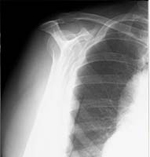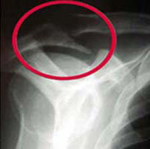Rotator Cuff Conflict Syndrome / Tendinitis (Part Two)
Symptoms
Pain from the rotator cuff usually causes local swelling and sensitivity in the front of the shoulder. You may have pain and stiffness when you lift your arm. You may also have pain when the arm is lowered from a raised position.
In the beginning, symptoms may be mild. Patients often do not seek treatment at an early stage. These symptoms may include:
- Minor pain that is present both with activity and at rest.
- Pain that spreads from the front part of the shoulder down the arm
- Sudden pain with lifting and increasing movement
- Athletes in sports may have pain when throwing or serving a tennis ball
As the problem progresses, symptoms increase:
- Night pain
- Loss of strength and movement
- Difficulty in activities that require placing the arm behind the back.
If the pain appears suddenly, the shoulder can be quite sensitive. All movements can be limited and painful.
Doctor's Examination
Medical history and physical examination

The doctor will test the range of motion by having you move your arm in different directions. After discussing your symptoms and medical history, the doctor will examine your shoulder. The doctor will check to see if it is tender in any area or if there is any deformation. To measure the range of motion of your shoulder, the doctor will ask you to move your arm in several different directions. The doctor will also test the strength of your shoulder.
The doctor will also check for other problems with your shoulder. The doctor may examine your neck to make sure that the pain is not coming from a "nerve pinch-cervical disc herniation," and to exclude any arthritis.
Medical history and examination
Other tests that may help your doctor confirm your diagnosis include:
 |
 |
| Normal "outlet" view. | In the "outlet" view, a large spur rubbing against the rotator cuff is evident. |
Radiography: X-rays do not show the soft tissues of your shoulder like the rotator cuff but only show the bones, so a patient with pain from the rotator cuff may have a normal radiography. In special views, it may show a spur formation on the anterior edge of the acromion.
Magnetic Resonance Imaging (MRI) and Ultrasonography. These imaging examinations give us good views of the soft tissues like the rotator cuff. They can show fluid or inflammation in the Bursa and rotator cuff. In some cases, a partial tear of the rotator cuff can also be detected.
Hello,
A few months ago, while I was tightening a screw with a screwdriver, I felt a stabbing pain in the upper part of my arm from the back, which caused me a lot of difficulty in moving my arm for a few days. Over time, the pain subsided, but since then, the pain occasionally returns and circulates in the shoulder area from the shoulder blade and other parts. I haven't visited a doctor yet, thinking it's something minor and temporary, but although there are days when the pain eases and then returns again. I would like some advice from you and what the approximate symptom might be.
Thank you
Sent by Xhevahiri, më 12 December 2014 në 05:34
My wife suddenly started experiencing unbearable severe pain in her shoulder. In fact, she has been having mild pains since January of this year but they went away. Despite seeing an orthopedic doctor who, after examining her at the military hospital, prescribed medications for relief and treatment, she has been experiencing continuous severe pain for 2 days now. Please advise us on what we should do to prevent her from suffering like this
Sent by Bujar skudrina, më 24 June 2015 në 07:51